After the wonderful lunch at school, we were transported to another temple attraction in the afternoon: Angkor Thom.
Angkor Thom Entrances
Angkor Thom means “the great city” in Khmer, and it is built by Angkor’s greatest king, Jayavarman VII (reigned 1181-1219). Angkor Thom is surrounded by a square wall with a gate on each side and a moat (which was completely dry during the dry season when we visited). According to our tour guide, the moat is believed to contain crocodiles in the old days to protect the city.
After getting out from bus and walked for about 3 minutes, we arrived at the first attraction of Angkor Thom – The Victory Way and Victory Gate.
Along both sides of the Victory Way, there are statues of gods and demons holding the body of a giant naga, the Hindu creation myth of Churning of the Ocean of Milk. Most of the statues are headless nowadays, either being stolen or destroyed.
At the end of the Victory Way is the 8-meter tall Victory Gate which has guided the city since the 12th century. This is one of the five gateways into Angkor Thom. The name of the Victory Gate is from the legend where the king welcomed his army back from victory through the gate. Also, at the side of gate, you can clearly see the three-headed elephant plucking lotus flowers which are well-restored.
We walked along the wall of Angkor Thom, admiring its magnificence. After 15 minutes, we reached another gate of Angkor Thom-the East Gate or the Death Gate. (Or, according to Professor Kimes, the Gate to Hell!)
It is called the Death Gate because convicts were sent here to be executed. At the top of the gate, you can clearly see carved faces and the statues of naga.
We took a bus from there and traveled to the Terrace of the Leper King and the Terrace of the Elephants
Terrace of the Leaper King
After entering Angkor Thom from the Victory Gate, we arrived at the Terrace of the Leper King, whose name is derived from the statue of King Yasovarman sitting atop the terrace. King Yasovarman is called the Leper King because he died of leprosy in the 10th century. Some other scholars suggested that the statue represents Hindu god of death, Yama.
Tour guide told us that the statue we saw is a replica. The original one is now at the Cambodia National Museum in Phnom Penh. Both the original statue and this replica have two missing fingers, which indicate leprosy.
We got onto the top of the terrace by passing through a narrow passage between the richly decorated walls surrounding the terrace. These walls are 6 meters high and are carved with bas-reliefs that represent apsaras, nagas and other mythological creatures. Carvings facing outside have been largely eroded by the rain, but on the inner walls, we were able to see very clear apsara carvings.
Terrace of the Elephants
The Terrace of the Elephant is used for celebration and ceremony. It is a great platform that King and his guests can sit on to see the performance or welcome the victorious army. The wall of elephant terrace is decorated with the life-sized garudas (bird-like creatures with human face and eagle’s beak) and lions supporting the terrace.
Bayon Temple
After the Terrace of the Elephants, we walked to the south to visit the most famous feature in Angkor Thom, the Bayon Temple. Situated in the exact center of Angkor Thom, Bayon was built at the peak of the Khmer empire by King Jayavarman VII in the late 12th century. It was a temple originally dedicated to Mahayana Buddhism. However, after Jayavarman VII’s death, the temple was modified by subsequent Hindu and Theravada Buddhist kings to suit their own religious preferences.
From the entrance, Bayon Temple is simply magnificent. Tour guide told us that the temple originally had 54 towers, but now only 37 remains. Each tower hosts 4 gigantic faces, one on each side.
We climbed the steep stone steps onto the second level of the temple where we could admire the faces from a close distance. Carved on huge sandstones, all of these faces pose a peaceful smile, which have been dubbed as the “Mona Lisa of Southeast Asia”. There are many excellent photo opportunities at Bayon. At one spot, the tour guide helped me to take a photo with my nose “touching” the nose of a Buddha face in the distance.
Personally, I liked Bayon more than Angkor Wat because of its distinctive characteristics and the peacefulness I felt inside the temple.
By Qian and Tan-Chi

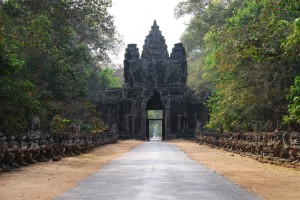
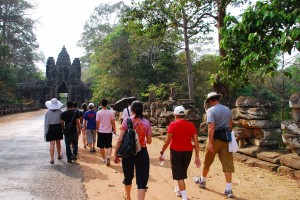
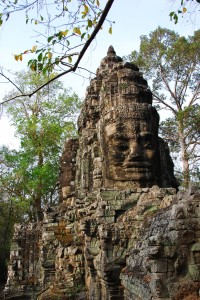
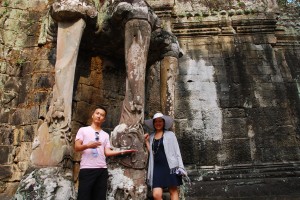
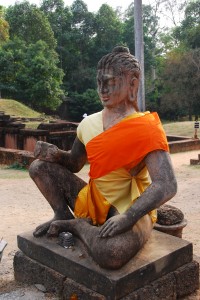
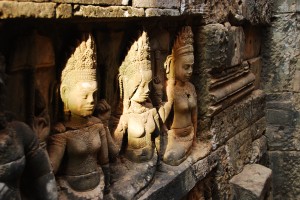

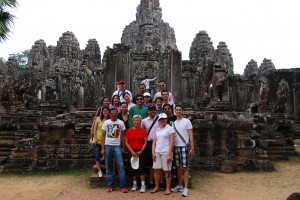
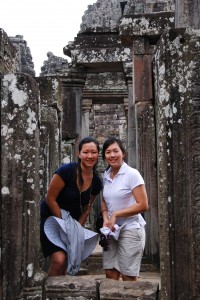
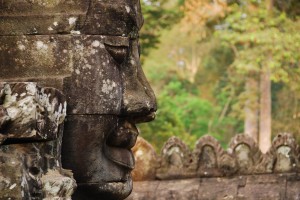
simply amazing
Great to hear about your project, although I’m confused by other questions. Now I’m actively seeking new job opportunities. To kick start this process, I prioritized crafting a strong resume, and I received invaluable assistance from this source https://skillroads.com/ Given my limited experience in the field, I recognize that a well-crafted resume is crucial for capturing the attention of potential employers.
Wow, what an incredible description of your visit to Angkor Thom! It’s amazing to imagine the history and grandeur of this ancient city. The statues of gods and demons along the Victory Way, and the magnificent Victory Gate must have been awe-inspiring to see in person. It’s a shame that so many of the statues are missing their heads, but the three-headed elephant plucking lotus flowers sounds like a stunning sight.
Your vivid account really makes me want to visit Angkor Thom myself someday. Exploring historical sites like this must be such a rewarding experience. Thanks for sharing this wonderful glimpse into your travels. By the way, if you’re looking to optimize the speed of your WordPress website, be sure to check out the WordPress Speed Optimization guide.
We stumbled over here by a different web page and thought I might check things
out. I like what I see so now i’m following you.
Look forward to exploring your web page for
a second time.
My webpage :: ดูการ์ตูน
You have very nice post and pictures, please have a look
at our photo tours in the temples of Angkor
antopie.org